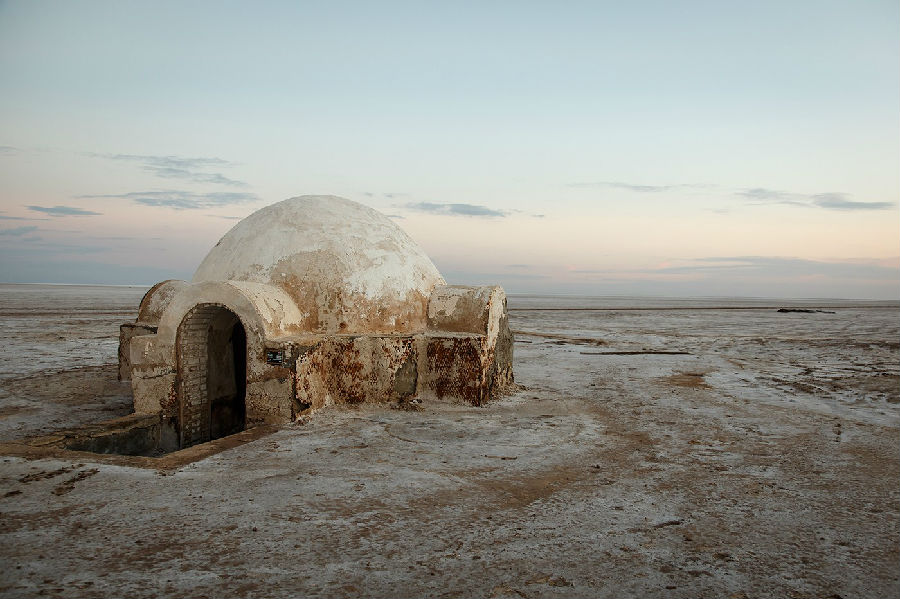(单词翻译:单击)
Have you ever wished you could jam with the cantina band in Mos Eisley, or watch a double sunset from a moisture farm?
你是否想过在莫斯埃斯利上观看星球大战,或者在湿气农场里观看双日落呢?
Well, you might be in luck, because in a study published this week in the journal Nature Astronomy,
如果是这样的话,那你就有福啦,因为本周,《自然天文学》杂志上发表了一则研究,
a group of researchers announced that they've spotted debris that might have come from a rocky planet
研究人员宣布,他们发现了一些残骸,这些残骸可能来自于一颗岩态行星,
that's part of a binary star system, a system with two stars instead of one.
而这颗岩态行星是某双星系统中的一部分,所谓双星系统就是有两颗恒星的系统。
In other words: we've found signs of a Tatooine-like planet.
换言之:我们发现了类塔图因行星的迹象。
I'm Stefan Chin, filling in today to bring you SciShow Space News. Now, we've found a planet in a binary star system before.
这里是《天空科学秀》,我是今天的主持人斯蒂芬·钦,现在呢,我们在发现了以前某双星系统的一颗行星。
Astronomers discovered the first one back in 2011, and since then they've found a few others.
2011年的时候,天文学家发现了第一颗双星系统中的行星。在那之后,他们又发现了几颗这样的星体。
But even though those discoveries led to plenty of headlines saying we'd found Tatooine,
但即便这样的发现霸占了各大头条版面,到处宣扬着我们发现了塔图因行星,
you wouldn't want to start a moisture farm on any of those other planets because they're all gas giants.
但你一定不会想要在这种行星上建造湿气农场,因为这些行星都是气体巨星。
It was still exciting though, because hey, planets with two suns!
不过,这种行星的存在还是足以让人感到兴奋,毕竟可是有两个太阳的行星呢哟喂!
Plus, in binary systems, the gravitational pull from both stars can make it hard for rocks to clump together to form rocky planets.
不仅如此,在双星系统中,来自两颗行星的引力让岩石很难凝结成块,因此也就无法形成岩态行星。
So astronomers thought that a real Tatooine or a slightly more similar one, anyway might not even be possible.
于是,天文学家认为,真正的塔图因行星或者说与之类似的星体,可能甚至并不存在。
Until now. Using two telescopes in Chile, the Gemini Observatory South telescope and the Very Large Telescope,
现在他们颠覆了自己的想法:智利通过使用两个望远镜,
the researchers found evidence of shattered asteroids around a star system far, far away called SDSS 1557.
双子南座望远镜以及甚大望远镜,这些研究人员发现,有证据表明有一个名为SDSS 1557的遥远星系附近存在破碎的小行星。
At first, the astronomers thought they were just looking at a single white dwarf: a small, very dense star, about 1000 light years away.
起初,他们以为他们观测到的只是单独的一颗白矮星,密度非常大,距离地球大概1000光年的距离。
But then they realized there was also a brown dwarf, a smaller, sort of "failed star" that's too small to begin fusing hydrogen and helium.
但随后他们发现还有一颗棕矮星,其体型较白矮星更小,有点“失败恒星”的意思,因为它体型过小,所以无法实现氢原子和氦原子的聚变。
The brown dwarf was hiding among the dust and debris around the white dwarf.
这颗棕矮星藏身于白矮星附近的尘土和残骸之间。
The white dwarf's gravitational pull is strong enough to drag in some of the debris around it, which changes the wavelengths of light the star emits.
由于这颗白矮星引力极强,足以拖拽住其周围的一些残骸,继而改变其所放射光的波长。
Using special instruments on the telescopes, the team was able to track and analyze those wavelengths, which can say a lot about what's in the debris.
通过这两个望远镜上的特殊装置,该研究组就可以追踪并分析这些波的波长,而通过波长可以表明大量关于残骸的信息。
So far, the stuff we've found flying around in binary systems has been mostly made of ice and carbon.
目前为止,这些双星系附近飞行着的物质大部分都是由冰和碳组成的。

But it looks like these asteroids are rich in elements like silicon and magnesium, which also make up rocky planets like Earth and Mars.
但观测的感觉就仿佛这些小行星富含硅和镁一样,而硅和镁也是组成岩态行星(如地球和火星)的元素。
Based on the amount of debris they measured falling into the white dwarf star, they think the asteroid it originally came from was at least four kilometers wide.
根据测量到的受白矮星引力牵引的残骸数量,他们认为残骸最初脱落下来的星体,直径至少有4000米。
If it's possible for such a large, rocky asteroid to form, that means many large asteroids could have come together and formed a rocky planet, too!
如果体积如此大、岩石含量如此多的小行星都能形成的话,那么很多体积庞大的小行星如果能聚集在一起,也可以形成岩态行星!
The astronomers plan to use the Hubble Space Telescope to take a closer look next year.
这些研究人员计划明年用哈勃望远镜来更近一步进行观察。
No word yet if the astronomers also saw what looks like a strange, small moon among the debris, but we're not complaining about that one.
目前还没有消息表明天文学家是否观测到残骸之中存在形态奇怪的小行星,但我们先不对此发表什么言论。
But even if it were real, the Death Star still probably wouldn't be the most dangerous thing in the universe.
但即便这是真的,死亡星球很可能依然不是宇宙里最为危险的事物。
Because according to another study out this week in Nature Astronomy,
因为根据《自然天文学》本周发表的另一则研究,
supermassive black holes are apparently ripping apart stars way more often than we used to think. Like, 100 times more often.
特大质量的黑洞明显撕扯星体的频率明显比我们以前想象的更高,大概是以前想象的100倍。
Astronomers used to believe it was pretty rare for a black hole to swallow a star, which is called a Tidal Disruption Event, or TDE.
以前,天文学家认为,黑洞几乎不怎么吞噬恒星,这种现象名为潮汐力瓦解耀斑(TDE)。
We'd only ever seen these acts of stellar cannibalism happen a few times in huge studies with thousands of galaxies,
只有在涉及数以千计星系的大型研究中,我们才见到过星系吞食的情况,而且也只有几次而已,
so we thought TDEs only happened once every 10,000 to 100,000 years per galaxy.
所以我们认为,在每个星系中,潮汐力瓦解耀斑只会在1万-10万年间发生一次。
But it looks like we may have underestimated black hole appetites.
不过,现在看来,我们可能低估了黑洞的食量。
In the new study, astronomers surveyed just 15 galaxies over 10 years, and even in this tiny sample,
在这项最新的研究中,天文学家观测仅观测了10年期的15个星系,但即便样本数量如此少,
they spotted a star giving off a huge flare of light which is kind of like a star's SOS signal as it's been ripped apart.
他们还是发现有一颗恒星可以放出巨大的光芒,有点像恒星被撕裂时发出的SOS信号。
Other objects, like supernovas, can give off bursts of light too,
像超新星这样的物体也是可以迸发出强光的,
but this flare's wavelengths and other properties were different than any supernova we've seen before.
但这次这种强光的波长和其他特质与我们以前观测过的任何超新星都不一样。
Instead, it looked like what we would expect to see from a TDE, which might suggest that TDEs aren't really that rare.
相反,就像我们在潮汐力瓦解耀斑里才能看见的现象一样,这可能表明潮汐力瓦解耀斑并不是什么稀有的现象。
We were just looking in the wrong place. See, for this study, the team focused on galaxies that were colliding with one another.
我们以前只是没观测到正确的地方,在这则研究中,研究小组专注于观测与彼此碰撞的星系。
Every large galaxy has a supermassive black hole in the middle, so when galaxies come together,
每个大型星系的中间部分都有一个特大质量的黑洞,所以当这些星系聚集在一起时,
a lot of new stars are formed, but those stars are also being formed right between two huge black holes.
就会形成许多新恒星,但这些恒星也是在两个巨大的黑洞之间形成的。
Lunch time! All this violence isn't really something we need to worry about in our own galaxy for the moment,
午餐时间到!所有这些猛烈发生的现象并不是我们此刻要在太阳系里需要担心发生的事,
but in 5 billion years, when the Milky Way crashes into the Andromeda galaxy, astronomers think TDEs will become much more frequent.
但50亿年后,银河系会消失在仙女座星系中。天文学家认为,等到那时候,潮汐力瓦解耀斑的出现频率会更高。
Instead of seeing a star get swallowed up every 10,000 to 100,000 years, we'll probably see it happen once every 10 to 100 years.
那时候,恒星受吞食就不再是1万-10万年间才会发生的事,而是10-100年间就可以发生的事。
And if humans manage to stick around to see it, well, good job humanity! You're in for quite the show.
而如果人类那时候依然没有毁灭,能亲眼见证这一切的话,就简直太棒了!我们也可以成为宏伟现象的观众了。
Black hole-gobbled stars that close to home would flash brighter than anything else in the night sky, so no telescope needed!
离地球距离很近的恒星,如果被黑洞吞食,就会发出亮彻夜空的光芒,那时候我们就不需要用望远镜来观测了!
Thanks for joining me for this episode of SciShow Space News, and thanks especially to our patrons on Patreon who help make this show possible.
感谢收看本期的《太空科学秀》,尤其要感谢我们的老朋友们,是你们让我们的节目走到了今天。
If you want to help us keep making episodes like this, just go to patreon.com/scishow.
如果您想继续观看与此类似的集锦,您可以登录patreon.com/scishow。
And don't forget to go to youtube.com/scishowspace and subscribe!
不要忘记登录并订阅youtube.com/scishowspace哦!


